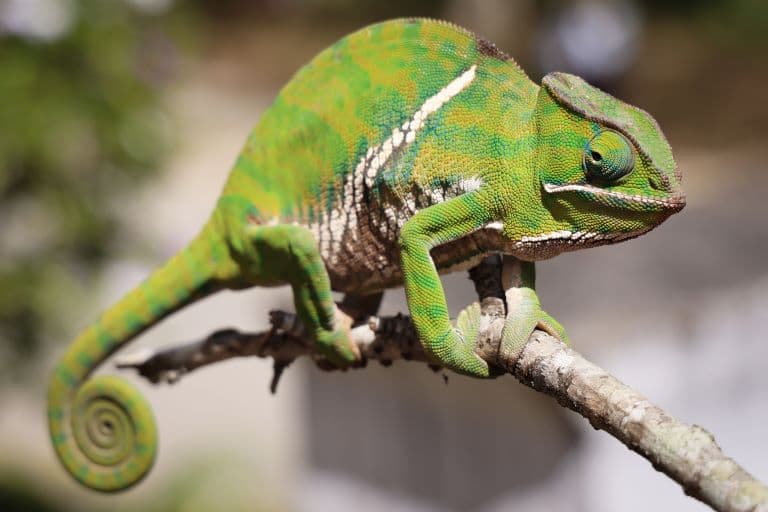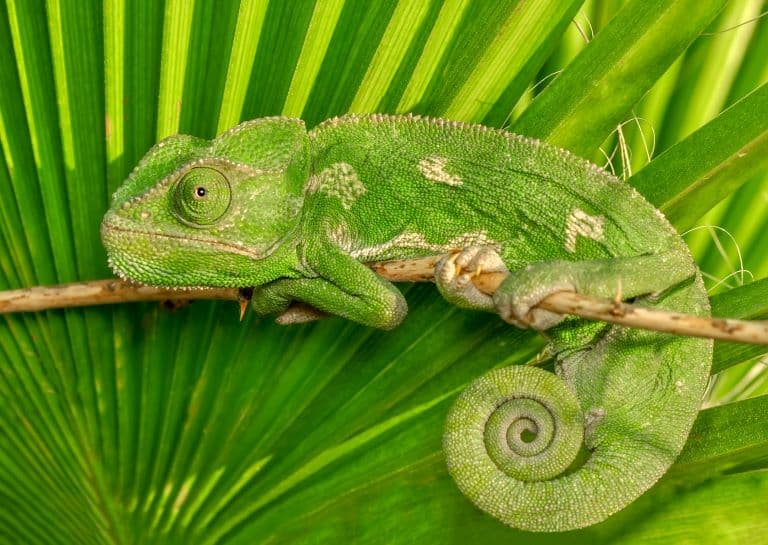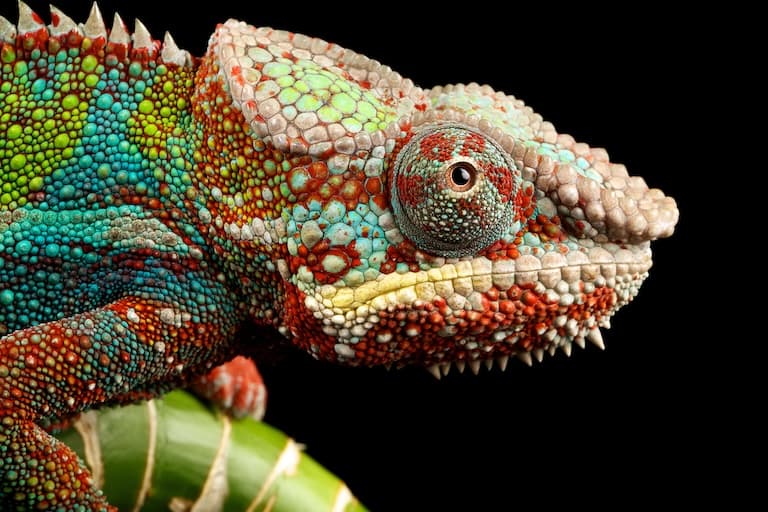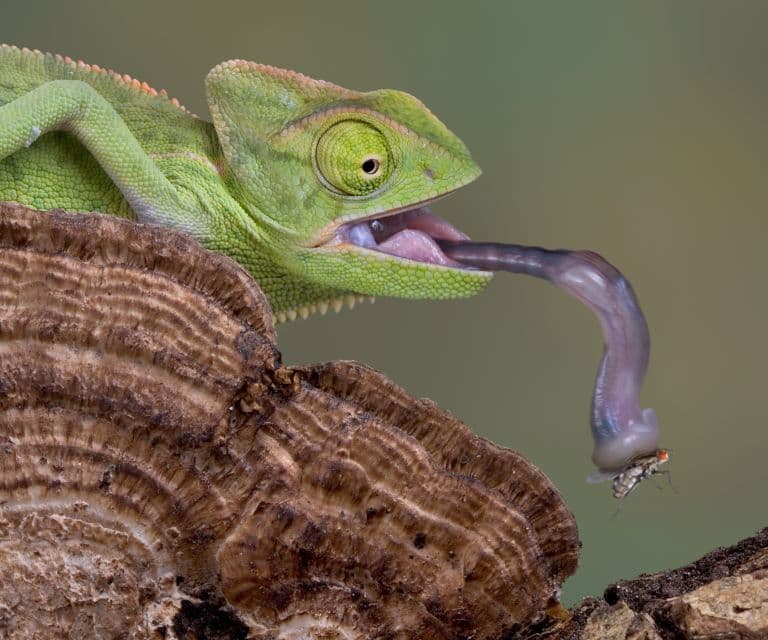Chameleon Profile
After the dinosaur extinction, most reptiles that remained were either terrestrial or learned to fly. But one group migrated up into the trees and never looked back.
Their name means Earth Lion, and while these lizards are entirely harmless to humans, chameleons are impressive ambush predators if you’re a small insect!

Chameleon Facts Overview
| Habitat: | Forests, grasslands, deserts, shrubbery |
| Location: | Mostly Africa, some Middle East, Iberia, some in Asia |
| Lifespan: | Up to 11 years in some species, 14 years in captivity |
| Size: | From 5cm (0.2 ft) to 60 cm (2ft) |
| Weight: | Largest species is 700g (25 oz) |
| Colour: | Varied |
| Diet: | Mostly insects, some plants |
| Predators: | Birds, monkeys, cats |
| Top Speed: | Slow |
| No. of Species: | Over 200 |
| Conservation Status: | Some species critically endangered (IUCN) |
Chameleons are a diverse family of slow-moving, mostly arboreal lizards. Madagascar has almost half of all known species, though they were once more widespread across the Old World.
Now, they’re common across Africa and Southern Europe, with a handful in Central Asia.
They’re tree and insect specialists and have unique adaptations to make the most out of both.
Interesting Chameleon Facts
1. They’re Paleocene reptiles
After the dinosaurs died (and 75% of the total life on Earth), there were quite a few opportunities for the surviving animals to radiate out. This is how mammals became the dominant class, having previously been kept out of most of the good jobs by their reptilian overlords.
But many reptiles survived, too, perhaps most successful were the theropod survivors. Small dinosaurs that made use of feathers and lightweight bones to occupy three-dimensional niches mammals couldn’t. These are still around today in the form of around 10,000 species of birds.
But other reptiles survived, too. And chameleons show up in the fossil record as far back as a few million years after the dinosaur extinction. They are likely a branch from the common ancestor of agama lizards and iguanas, originating from before the asteroid impact, and radiating out significantly after it. 1
2. They’re (mostly) arboreal
While the closest cousins of the chameleon chose the terrestrial path, chameleons became tree specialists. Aside from a small number of desert species (living in places with no trees), chameleons are pretty much all arboreal and they have some specialised adaptations to work with.
Firstly, their feet are weird. We take it for granted that we can grip things with our opposable digits (we’re an ex-arboreal species ourselves) but most animals have all their fingers pointing the same way.
Chameleons don’t; they have paired fingers, opposing one another, to wrap around branches. Some call this zygodactyly, which comes from parrots, but they have only four toes, while chameleons have five.
This has led to some complaints about using it to describe chameleon feet, but this is one of those arguments that only matters to about three people. 2

3. They can change colour
This, on the other hand, is what people love about chameleons. Chameleons change colour well and for several reasons. They can present certain colourations based on their social status, temperature, mood, level of sexual arousal, or how much they want to blend into their foliage and hide.
Their skin is covered in lattices of stretchy molecules that can change shape to reflect different colours, allowing the lizard to display the appropriate information based on the varying contexts.
For example, when one is angry, it’ll display brighter colours. When it submits, darker ones. Females display their period tracker data via the colour of their skin, showing males when they’re up for it and when they very much are not.
They can also change colour to absorb more or less of the sun’s heat, where necessary. 3
4. They’re smart about it
But for a lizard with few defences, bright colouration might draw unwanted attention so camouflage is equally important.
Some species adjust their camo based on the quality of the vision of the expected predator. When an introduced population of African chameleons was placed in the relative safety of Hawaii, they stopped using as much camouflage when they figured out there wasn’t anything there that wanted to eat them.
5. They also use texture
The skin of chameleons is often knobbled and/or crested, further breaking up the shape of the animal against its leafy background.
This is a textured approach to camouflage that adds another dimension to its ability to hide. It’s thought that these crests are what gave it the name “tree lion”.

6. Their eyes are amazing
Chameleon eyes are unusual, to say the least. Their eyelids are almost fused together and form a small pinhole in just the right place to see through. Each can move independently, so the lizard can have a 360-degree view of its surroundings without moving its head.
They have depth perception in each eye separately, and have the highest relative magnification of any vertebrate, and can see in ultraviolet light.
These eyes allow the chameleon to spot prey without drawing attention to itself by moving. And then, the hunt is on. 4
7. And their tongues are terrifying
All chameleons eat insects, and they do so by rocketing out a sticky appendage from their mouths in fantastic fashion.
These tongues can be twice the length of their bodies, even longer in juveniles, and act as a ballistic projectile, shot from the jaw with impressive accuracy.
A mouth shot from one of these bad boys can occur in less than 0.07 seconds and involves forces of up to 41 g. This rapid-fire attack comes from a combination of muscle contractions and elastic recoil of the tongue muscle, amplifying the force from the muscle. 5

8. They can thermoregulate
Most lizards slow down when they get cold, but chameleons have rudimentary thermoregularitoradaptations that allow them to keep moving in the early hours, while other reptiles are still a bit too chilly to come out.
Insects, too, are sluggish in cooler temperatures, so food is more available, and the tongue itself, because of this elastic recoil property still works in the event of slower muscle function. Retracting the tongue is done through pure muscle contraction, so will be slower when the lizard is cold, but by then the prey item is firmly secured on the sticky suction cup tongue.
In the terrestrial desert species known as the Namaqua chameleon, thermoregulation occurs through strategic colour shifting too, and like the thorny devil, this lizard can absorb moisture from the air through channels in its skin and via capillary action channel it to the mouth for drinking.
9. They can see each other’s bones
When you look at a chameleon, you see its skin, but when they look at one another, they are looking much deeper.
Chameleon bones glow in UV light, sometimes to the point where they can be spotted through the skin, especially by an animal like the chameleon, who can see the UV.
When scanned in a CT machine, their bones emit a bright blue glow that’s visible to the human eye, and the face was a different colour altogether, suggesting this is yet another way of signalling between individuals.
This might be a sexually-selected trait, but its real purpose is still uncertain.
Chameleon Fact-File Summary
Scientific Classification
| Kingdom: | Animalia |
| Phylum: | Chordata |
| Class: | Reptilia |
| Order: | Squamata |
| Family: | Chamaeleonidae |
Fact Sources & References
- “Chameleons”, Encyclopedia.com.
- “Panther chameleon feet”, Science Photo Library.
- (2021), “Do chameleons change their color to match their environment?”, Indiana University Bloomington.
- “Chameleon Eyes”, Ranger Rick.
- Derek E. Moulton (2016), “The elastic secrets of the chameleon tongue”, The Royal Society.
